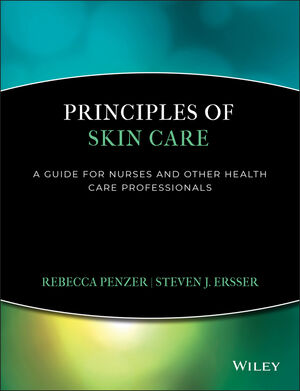Principles of Skin Care: A Guide for Nurses and Health Care PractitionersISBN: 978-1-4051-7087-1
Paperback
296 pages
May 2010, Wiley-Blackwell
 |
||||||
Chapter 1 Introduction.
What is skin?
Skin health.
What is in this book.
Conclusion.
References.
Part 1 Fundamental principles of managing the skin.
Chapter 2 Biology of the skin.
Introduction.
Skin structure.
Functions of the skin.
Skin and ageing.
Conclusion.
References.
Chapter 3 Assessment and planning care.
Introduction.
Assessment.
Planning care.
Intervention.
Evaluation.
Conclusion.
References.
Chapter 4 Protecting the skin and preventing breakdown.
Introduction.
The concept of skin vulnerability.
What causes skin breakdown?
Preventative practices.
Nursing intervention to support behavioural change (prevention) in relation to sun exposure.
Nutrition to support skin integrity.
Preventing skin damage by scratching.
Conclusion.
References.
Chapter 5 Emollients.
Introduction.
Definition.
Constituents of emollients.
Potential side effects.
Emollient formulations.
How emollients work?
Considerations that will effect how patients use emollients.
Conclusion.
References.
Chapter 6 Psychological and social aspects of skin care.
Introduction.
Social impacts.
Psychological impact.
Nursing interventions.
Conclusion.
References 100
Chapter 7 Helping patients make the most of their treatment.
Introduction.
Self-management and patient support.
The challenge of promoting treatment adherence.
Prescribing skin-related products and opportunities for medicines education.
Conclusion.
References.
Part 2 Principles of illness management.
Chapter 8 Psoriasis.
Introduction.
History of psoriasis.
Who gets psoriasis?
Biology of psoriasis.
Comorbidities associated with psoriasis.
Clinical variants of psoriasis.
Physical symptoms that accompany psoriasis.
Trigger factors in psoriasis.
Treatments for psoriasis.
Measuring quality of life.
Conclusion.
References.
Chapter 9 Eczema.
Introduction.
What is eczema?
Atopic eczema.
What is eczema commonly mistaken for?
Eczema severity assessment.
Caring for children with eczema.
Other forms of eczema in adulthood.
Contact dermatitis.
Treatment options for eczema.
Conclusion.
References.
Chapter 10 Acne.
Introduction.
What is acne?
Who gets acne and distribution.
Treatments.
Psychological impact.
Conclusion.
References.
Chapter 11 Skin cancer and its prevention.
Introduction.
Skin cancer epidemiology: the scale of the problem.
Pre-malignant skin lesions.
Non-melanoma skin lesions.
Introduction to melanoma.
Surgery.
Causation, risk prevention and early detection.
Nursing intervention and promoting self-examination.
Conclusion.
References.
Chapter 12 Infective skin conditions and infestations.
Introduction.
Bacterial skin infections.
Viral infections.
Fungal infections.
Infestations.
Conclusion.
References.
Chapter 13 Less common skin conditions.
Introduction.
Blistering conditions.
Connective tissue disorders.
Drug reactions.
Lichen planus.
Pityriasis rosea.
Primary cutaneous T-cell lymphomas.
Rosacea.
Urticaria.
Vitiligo.
Conclusion.
References.
Appendices.
Appendix 1 – The psoriasis area severity index (PASI).
Appendix 2 – The SCORAD index.
Appendix 3 – Examples of emollients with excipients.
Index.



